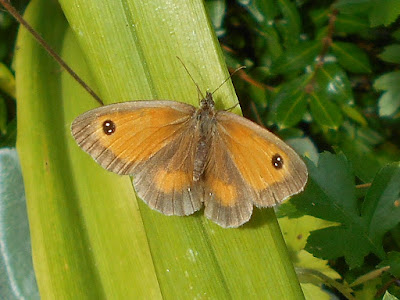 |
| Tutsan is a rather rare British native... |
I was delighted to find a strongly-growing specimen today in Byfield Pocket Park, but how did this theoretically rare plant come to be there? A wild flower mix seems the most likely answer. In fact it is quite common around buildings and on waste ground as a garden escape and I suspect that few non-botanists realise that it is a British native. With lovely buttercup-yellow flowers followed by scarlet berries it is the parent of several lovely garden hybrids but imo few are as attractive as the wild original.
 |
… but is widely naturalised. Byfield Pocket Park. 19 August, 2019
|
It is poisonous, causing nausea and diarrhoea if eaten. All this is theoretical for it seems that no cases of poisoning have ever been reported!
At the time of my visit it was only mid-morning and quite cool. The only butterfly noted was this Gatekeeper, soaking up the sun.
 |
This Gatekeeper was the only butterfly seen. Byfield Pocket Park.
19 August, 2019
|
In a similar way this tachinid fly, Tachina fera, was also warming itself but unfortunately would not approach closely enough for a decent photograph. The word 'fera' can mean 'fierce' but can also mean 'prickly' or 'spiny'. This striking fly bears many spiky bristles and so the second meaning may be the correct one here. However it is fierce in a sense, for its larvae are parasitic on noctuid moths. In fact all tachinid flies are parasitic - fascinating but ghoulish!
 |
This specimen of Tachina fera fly kept its distance. Stefen Hill
Pocket Park. 19 August, 2019
|
The yellow-berried Guelder Rose, Viburnum opulus 'Xanthocarpum' was heavy with fruit but, as with most viburnums its leaves had been badly damaged by the Viburnum Leaf Beetle, Pyrrhalta viburni. It is a native beetle but seems not to have been a pest until the mid-20th century and in 2010 this insect was declared 'number one pest species' following a survey by the Royal Horticultural Society.
 |
This yellow-berried viburnum was heavy with fruit.
Byfield Pocket Park, 19 August, 2019
|
Gorging themselves on nectar from a clump of marjoram nearby were numerous Bumblebees, together with a small, slightly odd-looking wasp. Could it be... Yes, a closer look showed that it was a conopid fly. To be precise it was Conops quadrifasciatus, perhaps the most widespread species and a parasite of the bumblebee Bombus lapidarius. And it was new for the site.
To top it all I gathered a fine collection of beetles to peruse later.
Postscript 20 8.2019
Chris and I went to Dobbies garden centre, near Dunchurch, today. There was Tutsan on sale.
To top it all I gathered a fine collection of beetles to peruse later.
Postscript 20 8.2019
Chris and I went to Dobbies garden centre, near Dunchurch, today. There was Tutsan on sale.
 |
Hypericum 'Magical Red' at Dobbies Garden Centre.
20 August, 2019
|
It had been given the name 'Magical Red' although how the name could be justified I've no idea.
To my mind it wasn't as good as the plant in Byfield Pocket Park, and a ridiculous price had been placed on it.
No comments:
Post a Comment